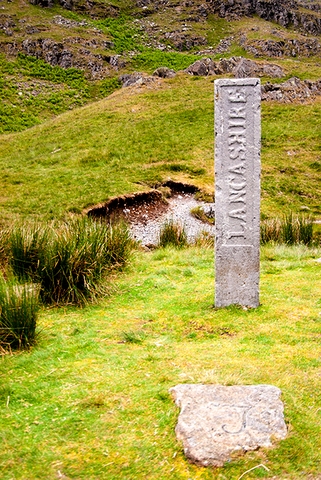Given that we’re very clearly located in just the one ‘shire’, the
beautiful county of Cumbria, you could easily be forgiven for being a
little puzzled.
Well if you travel 42 years back in time, and a couple of miles up the road, you’ll find the answer!
You see, prior to the reorganisation of the English counties which took place in 1974, the county of Cumbria didn’t actually exist. Cumbria as we know it today was created by combining the former counties of Cumberland and Westmorland, along with the part of Lancashire which lay to the north of Morecambe Bay. One might suppose that being impartial and naming the new county something like Cumwesland was considered rather cumbersome (pardon the slight pun) and so Cumberland, which was by far the largest of the three old counties making up the new Cumbria, got to dominate the name.
Anyway, the point at which these three counties all met was at the Wrynose Pass, where the tortuously twisting and dramatically scenic road rising out of the Little Langdale valley reaches its summit. Here you’ll find a large limestone monolith known as the Three Shire Stone. It was cut and carved in 1816 for a gentleman by the name of William Field, who bore the grand title of Furness Roadmaster; although for some reason it wasn’t actually erected until 1860. Perhaps that’s how long it took to lug the thing all the way up to the pass? On the front it bears the inscription ‘Lancashire’. Why just Lancashire? Presumably because it was carved in the village of Cartmel, which at the time lay in Lancashire, and to add ‘Westmorland’ and ‘Cumberland’ would have needed one heck of a big stone. And on the reverse it carries the simple legend ‘WF 1816’.

Unfortunately, in 1997, a particularly incompetent parking manoeuvre resulted in the stone being smashed into four pieces; but thankfully it was successfully restored, and the National Trust even had the sense to relocate the car park rather than the stone, in a bid to avoid further mishaps!
So the Three Shires Inn draws its name from the Three Shire Stone (and if you find the missing ‘S’ anywhere on your travels, do let us know!) It’s well worth a visit while you’re staying with us, as it makes a truly inspiring viewpoint with the high mountains all around, along with staggering views back down into the valley far beneath. It’s also an excellent starting point for walks to peaks such as Pike of Blisco or Swirl How and Wetherlam, or indeed the first high point on a driving (or, dare we even suggest, cycling) tour of the high Lakeland passes.
In fact, we’ll be featuring some of the dramatic and extreme driving and cycling routes over these stunning mountain roads in future blogs, so do be sure to keep returning and pick up even more tips for terrific days out around the Three Shires Inn.
Posted:
Category:
History
Author: Andrew



